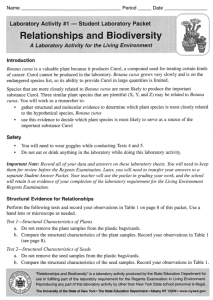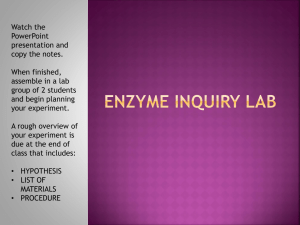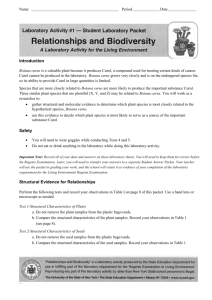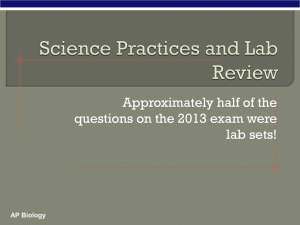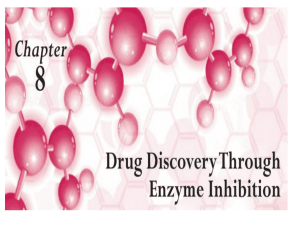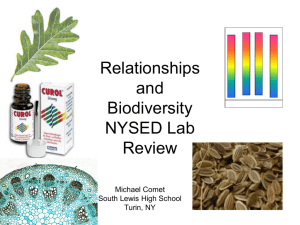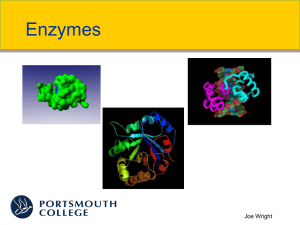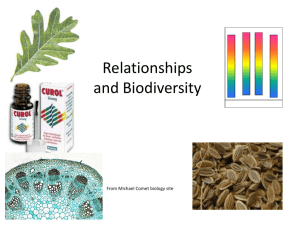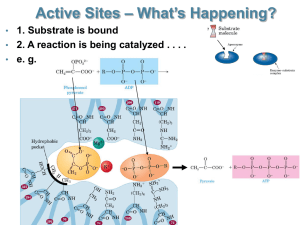6.12 Class PPT Biodiversity lab day 2
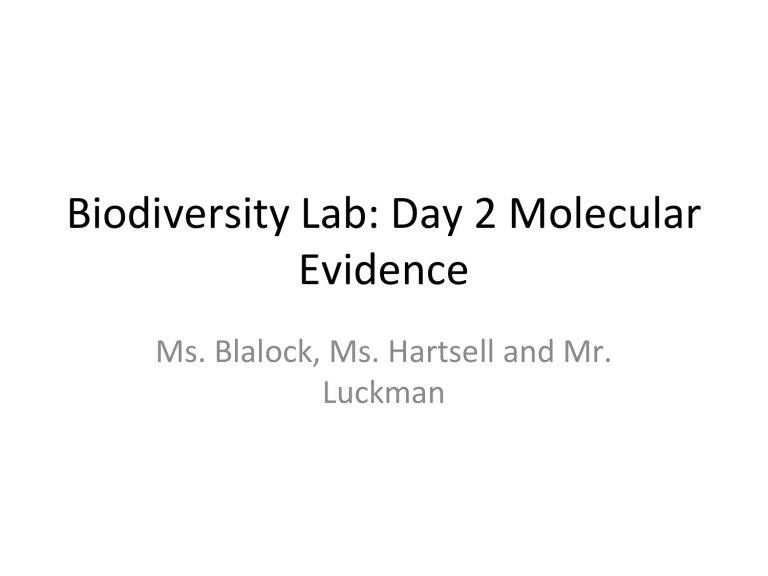
Biodiversity Lab: Day 2 Molecular
Evidence
Ms. Blalock, Ms. Hartsell and Mr.
Luckman
Do Now
• What are some techniques that you can use to determine if two species are similar?
AIM
• How can we use molecular evidence to determine the relationships between species?
Agenda
• Do Now
• INM: Paper Chromatography
• Test 1: Paper Chromatography
• Test 2: Indication Test for Enzyme M
• Test 3: Translating DNA
• Exit Ticket
Molecular Evidence
• Yesterday in lab, we used structural evidence to determine the similarities between Botana curus and three other unknown Species X, Y and Z
• Today in lab, we will be using molecular evidence to determine which of the Species (X, Y or Z) is most similar to Botana curus.
• Molecular evidence just refers to looking at the similarities and differences of different species based on the molecules (pigments, proteins, DNA) that make up each of the species.
• We will be performing three different tests to collect this molecular evidence
– Paper Chromatography
– Indication Test for Enzyme M
– Translating DNA into amino acids
Making observations
• Observations will play a key role in collecting molecular evidence.
• Specifically, in the Paper Chromatography and Enzyme M tests, observations will be made and recorded about the nature of the reactions that occur.
INM: What is paper chromatography?
• Paper chromatography is a procedure used to separate substances in a mixture.
• In this lab, this mixture is a solution of liquid pigments containing different kinds of chlorophyll
– It is referred to as “ plant extract ”
Turn and Talk
• What is the importance of chlorophyll to a plant?
Separation of pigments
• The different chlorophyll and other photosynthetic pigments separate out into patterns called “bands”
• These bands are made up of different colors.
How does it work?
Each of the green dots (A, B, C and D) represent plant extract each being from a different species of plant.
What do the results tell you?
• Plant species that are genetically similar will have similar colors and banding patterns.
Test 1: Paper Chromatography
• Directions: Using the procedure and PowerPoint titled “ Chromatography”, go through the process of paper chromatography.
• Purpose: To determine which Species (X, Y or Z) has similar colors and banding patterns as Botana
curus.
• Task: Complete steps 1-7 for the next 15 minutes
Indication Test of enzyme M
Botana curus is a plant that produces curol, which is a compound used to treat certain kinds of cancer.
There exists no good tests to indicate the presence of curol in plants.
However, if a plant produces the enzyme called “enzyme
M”, this is a good indication that the plant also produces curol
Presence of enzyme M = presence of curol
What happens if enzyme M is present?
• Just like iodine is an indicator for starch, there exists an indicator for enzyme M.
• When this indicator comes into contact with a substance that contains enzyme M, the solution will “fizz” or bubble up.
• This means that if enzyme M is NOT present then there will be no reaction
– In other words, nothing will happen
Making connections (3 min)
• How do you predict the plant extract from
Botana curus will react with the enzyme M indicator? Provide reasoning for your response
• Return to the second page of your guided notes to answer this question.
Test 2: Indication of enzyme M
• Directions: Following the instructions in your procedure packet, determine which species
(X, Y or Z) contains enzyme M
• Data: Once you have completed the test, record answers in Table 1 under “Indication of enzyme M” column
• You will have 12 minutes to complete this test.
Test 3: Translating DNA
• Directions: Following the instructions in your procedure packet, determine which Species (X, Y or Z) contains the most similar amino acid sequence to Botana curus.
• Data: Record results in Table 1 under “
Translating DNA”
• Time: You will have 10 minutes to complete this test.
Exit Ticket
Finish Early?
• Which of the molecular tests ran today do you think is the most accurate at determining relationships between species?
• Provide reasoning for your response.
Finish early?
• What was the reasoning behind testing each species for enzyme M?
• How did you know if enzyme M was present?
Finish Early?
• How does knowing the amino acid sequence help determine the relationship between species?
• Explain the relationship between a gene and a protein.
